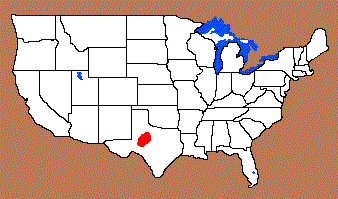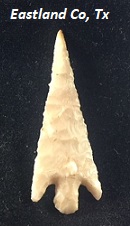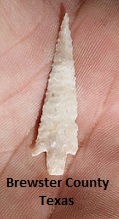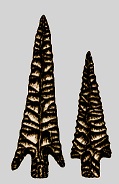Other Websites with Detailed Information:
Name Details:
Named By: Robert E. Forrester
Named For:
Town of Moran, Shaclkelford County, Texas where type site is near
Date Identified: 1951
Type Site: Salt Prong
Burial Site, Shackelford County, Texas
Moran
Cluster:
Commonly Utilized Material:
Date:
Cultural Period:
1,300 - 800 B.P.
Late Prehistoric
Vandal Minimum to
Medieval Warm
Blow Out Mountain Culture
Glacial Period:
Culture:
Outline is Representative of Size and Shape:
Description of Physical Characteristics and Flaking Pattern:
This is a thin
small triangular stemmed point with a flattened cross section. The blade is primarily straight, but may be recurvate flaring out at the shoulders edge. The blade is occasionally serrated. The shoulders may vary from horizontal to slightly barbed. The stem is narrow
and straight with a straight base. This point is commonly has a high quality of workmanship and has a random flaking pattern.
Size Measurements: Total Length - 25 to
50 mm, Stem Length - 6 to 8 mm, Blade Width - 10 to 14 mm,
Stem Width - 4 to 8 mm (***based on small sample size***).
Distribution:
Distribution Comments:
This point is primarily found in central Texas, around the Shackelford County region
including the counties of Callahan, Coke, Fisher, Jones, Mitchel, Nolan,
Runnels, Scurry, Shackelford, and Taylor of the Texas Panhandle.

Additional Comments:
Turner et al. (2011) notes that Moran points are
often assocaited with Chadbourne points.
Other points in this Cluster:
Point Validity: Valid Type
Forrester was an influential avocational
archaeologist who conducted extensive studies into Texas archaeology.
He published numerous professional publications. This type was named
in a professional publication and has many professional references.
This is considered a valid type.
.
Age Details:
References: (See Reference Page, Entry Number):
8, 23, 30, 182
Moran Projectile Point, Moran Arrowhead



